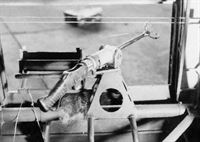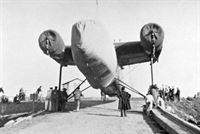Фотографии
-
The fuel-hose twin-reel arrangement in the forward fuselage of one of the Harrows, operated by the larger winch mechanism pictured right (a smaller winch was used forward of the main winch to play out and withdraw the hauling-line cable);
Самолёты на фотографии: Handley Page Harrow / H.P.54 - Великобритания - 1936
-
Регистрационный номер: G-AFRL [3] Harrow G-AFRL trails its hose during a refuelling exercise in the UK in the summer of 1939. By the time the 16 experimental transatlantic airmail flights had been completed at the end of September 1939, Cabot and Caribou had transported a total of around 13,000lb (6,000kg) of freight and mail.
Самолёты на фотографии: Handley Page Harrow / H.P.54 - Великобритания - 1936
-
Регистрационный номер: G-AFCU [3], G-AFRL [3] Steady as she goes - Harrow G-AFRL remained in the UK and undertook further development trials with Short S.30 G-AFCU Cabot during June-July 1939. Flight Refuelling issued a guarantee of "service in any part of the world to deliver 1,000gal of fuel in 10min, at speeds with existing equipment ranging from 110 to 125 m.p.h."
Самолёты на фотографии: Handley Page Harrow / H.P.54 - Великобритания - 1936Short Empire / S.23 - Великобритания - 1936
-
Регистрационный номер: G-AFCU [3], G-AFRL [3] Handley Page Harrow tanker G-AFRL feeds Short S.30 G-AFCU Cabot with fuel over the South Coast during trials in the summer of 1939. The “Ejector” method of contact developed by Flight Refuelling was sometimes referred to as “cow and calf”, whereby the tanker was the cow and the receiver the calf
Самолёты на фотографии: Handley Page Harrow / H.P.54 - Великобритания - 1936Short Empire / S.23 - Великобритания - 1936
-
Регистрационный номер: G-AFRG [7], K6933 [7] After trouble with the Harrows’ wheel fairings digging into the snow, the latter were removed, as seen in this photograph of G-AFRG flying past the hangar at Gander on a snowy day in late 1939. This machine became “794” in RCAF service and operated with the Test & Development Establishment at Rockcliffe, Ontario, until November 1941, when it was struck off charge.
Самолёты на фотографии: Handley Page Harrow / H.P.54 - Великобритания - 1936
-
One of the two Harrows at Gander was fitted with a ski tailskid for taxying experiments on the snow. Much of the information gained from the Harrows’ trials proved useful for subsequent operations from the airfield, which was used extensively by the RAF and USAAF as a stop for aircraft being ferried to Europe throughout the war.
Самолёты на фотографии: Handley Page Harrow / H.P.54 - Великобритания - 1936
-
The fuel-hose winch bolted to the floor of the Harrows. Marcus Langley, FRL's technical manager, also considered the use of the de Havilland Albatross as a tanker, although whether it would have had sufficient structural integrity to accomodate the equipment required is open to speculation.
Самолёты на фотографии: Handley Page Harrow / H.P.54 - Великобритания - 1936
-
Регистрационный номер: G-AFRG [7], K6933 [7] Anchors aweigh! Harrow G-AFRG minus its outer wings and tail aboard the SS Beaverford bound for Newfoundland in April 1939;
Самолёты на фотографии: Handley Page Harrow / H.P.54 - Великобритания - 1936
-
Регистрационный номер: G-AFRG [7], K6933 [7] Hugh Johnson building part of the ramp to get the aircraft off the scow and up the mole to the airfield at Longueuil;
Самолёты на фотографии: Handley Page Harrow / H.P.54 - Великобритания - 1936
-
The Birmingham Small Arms Co (BSA) supplied a gun capable of firing a 15in (38cm) steel rod with a grapnel on the end, which would take 300ft (90m) of 5cwt steel cable with it;
Самолёты на фотографии: Handley Page Harrow / H.P.54 - Великобритания - 1936
-
Регистрационный номер: G-AFRH, K7029 Following the completion of the transatlantic airmail experiment, Harrows G-AFRG and ’FRH remained at Gander to continue inflight refuelling trials in order to keep the crews current in case the service was resumed. With its refuelling equipment still fitted, 'FRH is seen here in October 1939, during which a dozen practice flights were completed.
Самолёты на фотографии: Handley Page Harrow / H.P.54 - Великобритания - 1936
-
Регистрационный номер: G-AFRG [7], K6933 [7] The Harrow towers above the crew at the top of the ramp track;
Самолёты на фотографии: Handley Page Harrow / H.P.54 - Великобритания - 1936
-
Регистрационный номер: G-AFRG [7], K6933 [7] The Harrow’s port mainwheel tyre pinches against the side of the ramp track, showing how little room for error there was. Adding to the crew’s headaches was the need to find suitable timber with which to make the tracks.
Самолёты на фотографии: Handley Page Harrow / H.P.54 - Великобритания - 1936
-
Регистрационный номер: G-AFRG [7], K6933 [7] With the legend "REFUELLING" emblazoned in large white letters across the top surface of its wing so as to avoid any confusion about its purpose, Harrow G-AFRG heads out over Newfoundland for another sortie. An average refuelling sortie would take around 15min to complete and would involve the transfer of some 850-950gal.
Самолёты на фотографии: Handley Page Harrow / H.P.54 - Великобритания - 1936
-
Регистрационный номер: G-AFRG [7], K6933 [7] Flight Refuelling’s Harrow G-AFRG after assembly at Fairchild’s airfield and factory at Longueuil, near Montreal, in May 1939. Large observation transparencies were incorporated into the Harrows’ forward fuselages’ fabric covering to give the operators the field of vision required to undertake the inflight refuelling operation.
Самолёты на фотографии: Handley Page Harrow / H.P.54 - Великобритания - 1936
-
Hauling-line from AW.23 snags wingtip-hook of Harrow; hook (attached to contact-line running beneath wing to Harrow cabin), sinker-weight and hauling-line drop free, to be hauled aboard Harrow; refuelling line attached to hauling-line and winched back to AW.23, which refuels and disconnects refuelling line when full; refuelling line hauled back aboard Harrow
Самолёты на фотографии: Armstrong Whitworth A.W.23 - Великобритания - 1935Handley Page Harrow / H.P.54 - Великобритания - 1936
-
THE “EJECTOR” OR “LOOPED-HOSE” METHOD. Illustrated here is the sequence of operations for the “Ejector” or “Looped-Hose” method of refuelling in flight, developed by Flight Refuelling Ltd during 1939-40.
Самолёты на фотографии: Handley Page Harrow / H.P.54 - Великобритания - 1936Short Empire / S.23 - Великобритания - 1936
-
Регистрационный номер: G-AFCU [3] Along with G-AFCV Caribou, Short S.30 G-AFCU Cabot was used on the 16 transatlantic airmail crossings using inflight refuelling undertaken between August 5 and September 30, 1939. On the outbound flight to New York on September 24, Cabot established a new record for the run between Foynes and Botwood, taking 13hr 2min.
Comparative studies of two Short Flying Boats of 1938/9 vintage. The Class C, or Empire Flying Boat represented by G-AFCU "Cabot" at Rochester about 1939. When first flown in November 1938 the Imperial Airways titling was level with the top of the access door!Самолёты на фотографии: Short Empire / S.23 - Великобритания - 1936
Статьи
- -
- B.Gardner - Fill 'er up!
- B.Taghvaee - The soviet SAM-jammer
- D.Stringer - The Viscount comes to America (2)
- E.Wild - The Melon Run
- G.Baughen - The case for appeasement?
- J.Mesnard - Tragique The Sud-Est SE.1010
- K.Hayward - Making a pig's ear from a silk purse..?
- M.Willis - From Skate to Sea Dart (1)
- N.Stroud - Channell-hopping with BEA /The John Stroud Archive/
- P.Davidson - Off the Beaten Track...
- P.Jarrett - Lost & Found
- R.Flude - Berlin or bust /The Axis's wartime air links/ (2)
- T.Lipscombe - RAF Far East Flight (1)

















